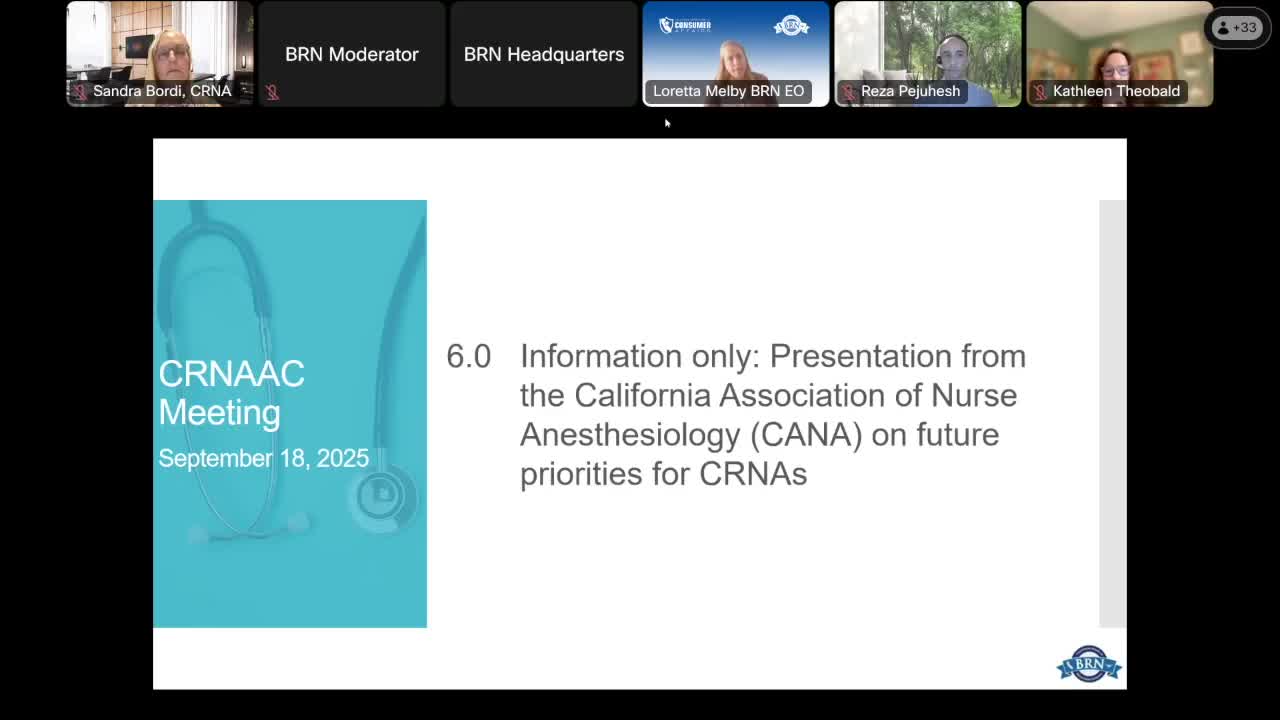Regulatory Board Discusses CRNA Regulations and Public Comment Process
September 30, 2025 | Respiratory Care Board of California, Boards and Commissions, Executive, California
This article was created by AI summarizing key points discussed. AI makes mistakes, so for full details and context, please refer to the video of the full meeting. Please report any errors so we can fix them. Report an error »

The BRN Certified Registered Nurse Anesthetist (CRNA) Advisory Committee Meeting, held on September 18, 2025, by the Respiratory Care Board of California, focused on the regulatory processes affecting CRNAs and their practice. The meeting aimed to clarify the board's role in addressing the needs of CRNAs while adhering to existing statutory limitations.
The discussion began with an overview of the regulatory framework guiding the board's actions. It was emphasized that any changes to regulations must align with current laws, and the board cannot create new laws through regulation. The regulatory attorney's input will be crucial in determining what adjustments can be made to better support CRNAs in their practice settings.
The committee acknowledged potential disconnects between the desires of CRNAs and the board's regulatory capabilities. While the board aims to capture the practices CRNAs have been following for the past four years, it cannot expand their scope of practice without legislative support. The intent is to clarify existing regulations rather than introduce new practices.
The regulatory process was outlined, highlighting the importance of public comment. Once proposed regulations are drafted, they will be subject to a public comment period, allowing stakeholders to provide feedback. The board will review all comments and may amend the regulations based on this input. Significant changes will require a longer public comment period, while minor adjustments may only need a brief review.
The committee also discussed the potential for hearings on the regulations, where further public input could be gathered. The timeline for these regulatory changes is uncertain, typically ranging from one to two years, depending on the volume of comments and any legal challenges that may arise.
In conclusion, the meeting underscored the board's commitment to working collaboratively with CRNAs while navigating the complexities of regulatory compliance. The next steps involve drafting regulations that reflect the committee's input and addressing public comments to ensure that the final regulations align with both the needs of CRNAs and the legal framework governing their practice. Public comments were invited at the end of the meeting, allowing for further engagement from stakeholders.
The discussion began with an overview of the regulatory framework guiding the board's actions. It was emphasized that any changes to regulations must align with current laws, and the board cannot create new laws through regulation. The regulatory attorney's input will be crucial in determining what adjustments can be made to better support CRNAs in their practice settings.
The committee acknowledged potential disconnects between the desires of CRNAs and the board's regulatory capabilities. While the board aims to capture the practices CRNAs have been following for the past four years, it cannot expand their scope of practice without legislative support. The intent is to clarify existing regulations rather than introduce new practices.
The regulatory process was outlined, highlighting the importance of public comment. Once proposed regulations are drafted, they will be subject to a public comment period, allowing stakeholders to provide feedback. The board will review all comments and may amend the regulations based on this input. Significant changes will require a longer public comment period, while minor adjustments may only need a brief review.
The committee also discussed the potential for hearings on the regulations, where further public input could be gathered. The timeline for these regulatory changes is uncertain, typically ranging from one to two years, depending on the volume of comments and any legal challenges that may arise.
In conclusion, the meeting underscored the board's commitment to working collaboratively with CRNAs while navigating the complexities of regulatory compliance. The next steps involve drafting regulations that reflect the committee's input and addressing public comments to ensure that the final regulations align with both the needs of CRNAs and the legal framework governing their practice. Public comments were invited at the end of the meeting, allowing for further engagement from stakeholders.
View full meeting
This article is based on a recent meeting—watch the full video and explore the complete transcript for deeper insights into the discussion.
View full meeting
